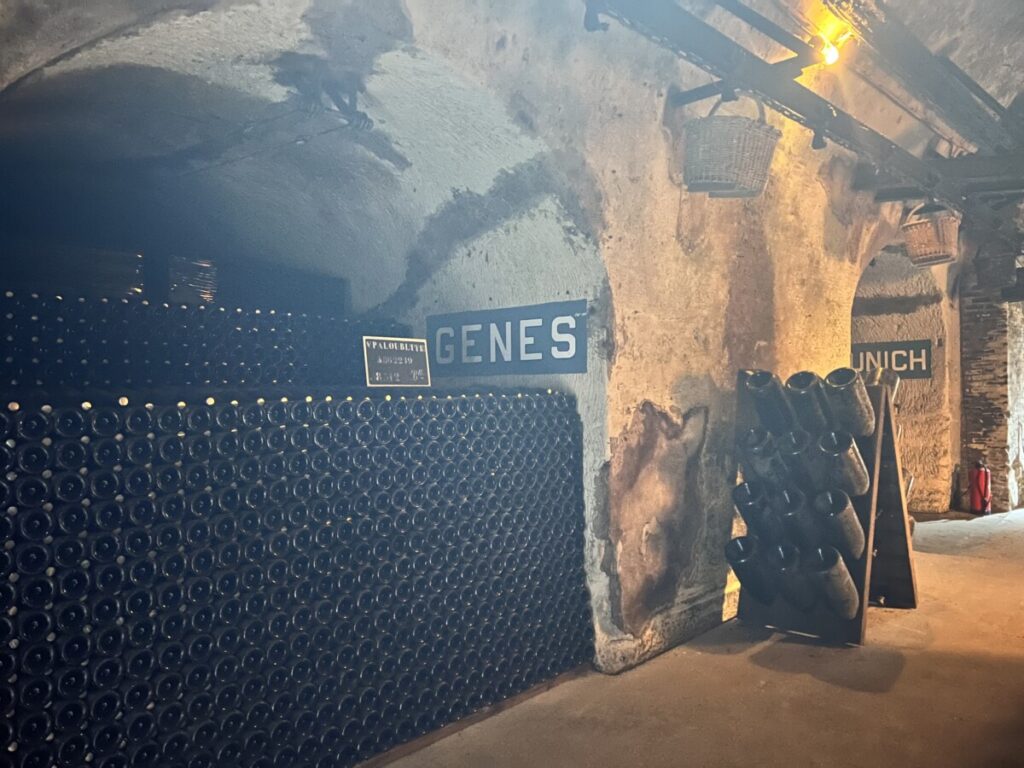On Saturday, June 11th, Cynthia, Lauren, Sam, and I took a day trip to Reims, the unofficial capital of the Champagne wine-growing region. We left first thing in the morning for the 45-minute high-speed train ride out through the countryside to make the most of our day away. We started off getting breakfast at a local café on what appeared to be the main street of the city. After, we had our first champagne tasting. Personally, I do not like to drink but was excited to take a sip of each for the experience of tasting France’s finest! After this tasting, we walked around the city and grabbed lunch before our second tasting. While walking, we saw Cathedrale Notre-Dame de Reims and Basilique Saint-Remi. Both beautiful. Our last stop of the day was the Pommery house where we toured the cellars and learned about how champagne is made and stored.

At our second tasting, the staff was asking us to pay close attention to the taste and flavors. We also smelt every champagne before testing. We learned that the proper way to drink champagne is to inhale through your nose while taking a small sip to get the most of the flavors. This trip was right after we reviewed the article on covid and olfaction, so it made me think about the connection between olfaction and taste.

In the article we discussed in class, we learned that covid-19 could cause anosmia, loss of sense of smell, due to damage to sustentacular cells (Bryche et al., 2020). However, studies have shown that in addition to losing the sense of smell, people also lose their ability to taste (Parma et al., 2020). While many individuals regain their ability to smell and taste after having covid, some have these abilities return in an unpleasant way, by developing parosmia. Parosmia is a type of olfactory dysfunction that causes distorted smell and taste. Patients with parosmia will describe food as tasting/smelling like sewage and other unpleasant descriptors (Walker et al., 2022). I found this disorder fascinating to learn about since damage to olfactory cells causes abnormalities in taste, illustrating that these two sensory systems are connected.
Something I hope to do in my career as a scientist, and hopefully physician, is to use a big picture approach. To understand that so many systems are connected and need to be explored together to be fully understood. I felt that I did just that in this experience.
References:
Bryche, B., St Albin, A., Murri, S., Lacôte, S., Pulido, C., Ar Gouilh, M., Lesellier, S., Servat, A., Wasniewski, M., Picard-Meyer, E., Monchatre-Leroy, E., Volmer, R., Rampin, O., Le Goffic, R., Marianneau, P., & Meunier, N. (2020). Massive transient damage of the olfactory epithelium associated with infection of sustentacular cells by SARS-CoV-2 in golden Syrian hamsters. Brain, Behavior, and Immunity, 89(July), 579–586. https://doi.org/10.1016/j.bbi.2020.06.032
Parma, V., Ohla, K., Veldhuizen, M. G., Niv, M. Y., Kelly, C. E., Bakke, A. J., Cooper, K. W., Bouysset, C., Pirastu, N., Dibattista, M., Kaur, R., Liuzza, M. T., Pepino, M. Y., Schöpf, V., Pereda-Loth, V., Olsson, S. B., Gerkin, R. C., Rohlfs Domínguez, P., Albayay, J., … Restrepo, D. (2020). More than smell – COVID-19 is associated with severe impairment of smell, taste, and chemesthesis. Chemical Senses, 45(7), 609–622. https://doi.org/10.1093/chemse/bjaa041
Walker, A., Kelly, C., Pottinger, G., & Hopkins, C. (2022). Parosmia-a common consequence of covid-19. BMJ (Clinical Research Ed.), 377, e069860. https://doi.org/10.1136/bmj-2021-069860
